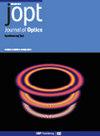传播损耗对硅中光子对生成的影响
IF 2.7
4区 物理与天体物理
Q3 OPTICS
引用次数: 0
摘要
我们提出了一个半经典数值模型,用于估算线性散射损耗和非线性吸收损耗对硅纳米波导中通过自发四波混合产生的双光子通量及其量子相关性的影响。随着损耗的增加,观测到的量子对相关性的增强与直觉相反,这归因于多光子产生的意外计数减少所产生的主导效应,同时对光源亮度进行了相应的权衡。研究表明,即使存在 1 dB/cm 的线性传播损耗和非线性损耗(双光子吸收 (TPA) 和自由载流子吸收 (FCA)),在输入泵浦功率为 1 mW、长度为 1 厘米的情况下,硅纳米波导也能产生高度相关的成对光子,其偶然与巧合比 (CAR) 高达 ∽3400,光谱亮度为 2.8×105 对/s/GHz/mW。损耗和相应的朗格文噪声使用沿波导长度分布的分束器进行建模,以封装与背景储层(真空波动)的现象耦合。与以前的分析模型相比,所提出的数值模型更具通用性,特别是在包括色散和波长相关损耗方面,而且对于高光子通量机制(如光参量放大器和挤压态发生)中的噪声估算更为精确。本文章由计算机程序翻译,如有差异,请以英文原文为准。
Impact of propagation losses on photon-pair generation in silicon
We present a semi-classical numerical model to estimate the impact of linear scattering loss and nonlinear absorption losses on the biphoton flux and their quantum correlations generated via spontaneous four-wave mixing in silicon nanowaveguides. The counter-intuitive observed enhancement of pair correlations with increasing loss is attributed to the dominant effect of reduced accidental counts from multiphoton generation, with a corresponding trade-off for the source brightness. Silicon nanowaveguides are shown to be capable of generating highly correlated paired photons with coincidental-to-accidental ratio (CAR) as high as ∽3400 and spectral brightness 2.8×105 pairs/s/GHz/mW, even in the presence of linear propagation loss of 1 dB/cm and nonlinear losses (two-photon absorption (TPA) and free-carrier absorption (FCA)), over a length of 1-cm with an input pump power of 1 mW. Loss and the corresponding Langevin noise are modeled using distributed beam splitters along the waveguide length to encapsulate the phenomenological coupling to the background reservoir (vacuum fluctuations). The proposed numerical model is more general compared to previous analytical models, particularly for including dispersion and wavelength-dependent losses, and more accurate for noise estimation in the high-photon-flux regime such as optical parametric amplifiers and squeezed state generation.
求助全文
通过发布文献求助,成功后即可免费获取论文全文。
去求助
来源期刊

Journal of Optics
OPTICS-
CiteScore
4.50
自引率
4.80%
发文量
237
审稿时长
1.9 months
期刊介绍:
Journal of Optics publishes new experimental and theoretical research across all areas of pure and applied optics, both modern and classical. Research areas are categorised as:
Nanophotonics and plasmonics
Metamaterials and structured photonic materials
Quantum photonics
Biophotonics
Light-matter interactions
Nonlinear and ultrafast optics
Propagation, diffraction and scattering
Optical communication
Integrated optics
Photovoltaics and energy harvesting
We discourage incremental advances, purely numerical simulations without any validation, or research without a strong optics advance, e.g. computer algorithms applied to optical and imaging processes, equipment designs or material fabrication.
 求助内容:
求助内容: 应助结果提醒方式:
应助结果提醒方式:


